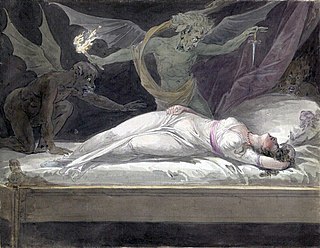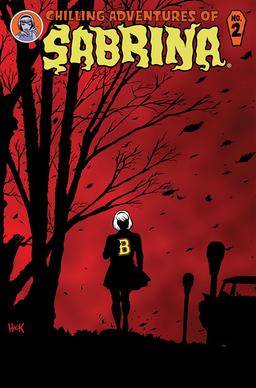Related Research Articles
A nightmare, also known as a bad dream, is an unpleasant dream that can cause a strong emotional response from the mind, typically fear but also despair, anxiety, disgust or sadness. The dream may contain situations of discomfort, psychological or physical terror, or panic. After a nightmare, a person will often awaken in a state of distress and may be unable to return to sleep for a short period of time. Recurrent nightmares may require medical help, as they can interfere with sleeping patterns and cause insomnia.
In English folklore, The Puck, also known as Goodfellows, are demons or fairies which can be domestic sprites or nature sprites.

Sleep paralysis is a state, during waking up or falling asleep, in which a person is conscious but in a complete state of full-body paralysis. During an episode, the person may hallucinate, which often results in fear. Episodes generally last no more than a few minutes. It can recur multiple times or occur as a single episode.

Valac is a demon described in the goetic grimoires The Lesser Key of Solomon, Johann Weyer's Pseudomonarchia Daemonum, the Liber Officiorum Spirituum, and in the Munich Manual of Demonic Magic as an angelically winged boy riding a two-headed dragon, attributed with the power of finding treasures.

An incubus is a male demon in human form in folklore that seeks to have sexual intercourse with sleeping women; the corresponding spirit in female form is called a succubus. Parallels exist in many cultures.
A shadow person is the perception of shadow as a living species, humanoid figure, sometimes interpreted as the presence of a spirit or other entity by believers in the paranormal or supernatural.

Sabrina the Teenage Witch is a comic book series published by Archie Comics about the adventures of a fictional American teenager named Sabrina Spellman. Sabrina was created by writer George Gladir and artist Dan DeCarlo, and first appeared in Archie's Madhouse #22. Storylines of the character at elementary-school-age also appear under the title "Sabrina -- That Cute Little Witch" in almost all of the Little Archie comics.

Witchcraft has been present throughout the Philippines even before Spanish colonization, and is associated with indigenous Philippine folk religions. Its practice involves black magic, specifically a malevolent use of sympathetic magic. Today, practices are said to be centered in Siquijor, Cebu, Davao, Talalora, Western Samar, and Sorsogon, where many of the country's faith healers reside. Witchcraft also exists in many of the hinterlands, especially in Samar and Leyte; however, witchcraft is known and occurs anywhere in the country.

A mare is a malicious entity in Germanic and Slavic folklore that walks on people's chests while they sleep, bringing on nightmares.

Sabrina Victoria Spellman is the eponymous character of the Archie Comics series Sabrina the Teenage Witch. Sabrina was created by writer George Gladir and artist Dan DeCarlo, and she first appeared in Archie's Mad House #22 in October 1962.
Popobawa, also Popo Bawa, is the name of an evil spirit or shetani, which is believed by residents of Zanzibar to have first appeared on the Tanzanian island of Pemba. In 1995, it was the focus of a major outbreak of mass hysteria or panic which spread from Pemba to Unguja, the main island of the Zanzibar Archipelago, and across to Dar es Salaam and other urban centres on the East African coast.

An Alp is a supernatural being in German folklore.
Pedro Penduko is a Filipino fictional comic book character created by National Artist for Literature Francisco V. Coching. The character, who is styled as a folk hero, debuted in the magazine Liwayway in 1954.

In Akkadian and Sumerian mythology, Alû is a vengeful spirit of the Utukku that goes down to the underworld Kur. The demon has no mouth, lips or ears. It would roam at night and terrifies people while they sleep and the Alû may also torment their victims for fun. It was also said that possession by the Alû would result in unconsciousness or a coma; in this manner it resembles creatures such as the mara, and incubus, which are invoked to explain sleep paralysis. In Akkadian and Sumerian mythology, it is associated with other demons such as the Gallu and the Lilu.
Hypnopompia is the state of consciousness leading out of sleep, a term coined by the psychical researcher Frederic Myers. Its mirror is the hypnagogic state at sleep onset; though often conflated, the two states are not identical and have a different phenomenological character. Hypnopompic and hypnagogic hallucinations are frequently accompanied by sleep paralysis, which is a state wherein one is consciously aware of one's surroundings but unable to move or speak.
Mythic humanoids are legendary, folkloric, or mythological creatures that are part human, or that resemble humans through appearance or character. Each culture has different mythical creatures that come from many different origins, and many of these creatures are humanoids. They are often able to talk and in many stories they guide the hero on their journey.

Sudden arrhythmic death syndrome (SADS) is a sudden unexpected death of adolescents and adults caused by a cardiac arrest. However, the exact cause of the cardiac arrest, and thus the exact cause of death, is unknown. These deaths occur mainly during sleep or at rest. One type of conduction defect known as Brugada syndrome can be responsible.

The night hag or old hag is the name given to a supernatural creature, commonly associated with the phenomenon of sleep paralysis. It is a phenomenon in which the sleeper feels the presence of a supernatural, malevolent being which immobilizes the person as if sitting on their chest or the foot of their bed. The word "night-mare" or "nightmare" was used to describe this phenomenon before the word received its modern, more general meaning. Various cultures have various names for this phenomenon and supernatural character.

Chilling Adventures of Sabrina is an American comic book series published by Archie Horror, an imprint of Archie Comics, beginning in 2014. The series is a darker take on the characters and setting of Sabrina the Teenage Witch. It is written by Roberto Aguirre-Sacasa, with art by Robert Hack, and is inspired by the appearances of Sabrina in Aguirre-Sacasa's other Archie series, Afterlife with Archie.

Chilling Adventures of Sabrina is an American supernatural horror television series developed by Roberto Aguirre-Sacasa for Netflix, based on the Archie comic book series of the same name. It ran from October 2018 to December 2020 for 2 seasons. The series is produced by Warner Bros. Television, in association with Berlanti Productions and Archie Comics. Aguirre-Sacasa and Greg Berlanti serve as executive producers, alongside Sarah Schechter, Jon Goldwater, and Lee Toland Krieger.
References
- ↑ Ramos, Maximo D. (1971). Creatures of Philippine Lower Mythology. Philippines: University of the Philippines Press.
- ↑ Weidenfeld, Lisa (October 26, 2018). "Sabrina goes to sleep and finds a whole lot of terrifying adventures". The A.V. Club . Retrieved February 24, 2019.
- ↑ Holmes, Martin (October 29, 2018). "'Chilling Adventures of Sabrina' Episode 5 Creeps Into Your Nightmares (RECAP)". TV Insider . Retrieved February 24, 2019.
- ↑ Stiles, Paula R. (5 July 2012). "RECAP AND REVIEW: LOST GIRL 2.11: CAN'T SEE THE FAE-REST". Innsmouth Free Press . Retrieved February 24, 2019.
- ↑ EVIL TAKES ROOT: The Curse of the Batibat, IMDb, Genre Labs, Elevate Pictures